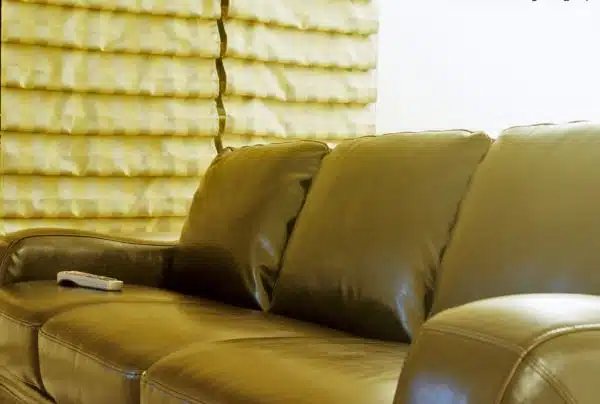Leather couches are one of the most luxurious and sophisticated pieces of furniture that can add elegance and charm to any living space. However, with time and use, leather couches may lose their luster and original color, leaving them looking dull and worn out. Dyeing a leather couch is a great way to restore its beauty and extend its lifespan.
As a leather upholstery specialist, I have seen many homeowners struggle with the process of dyeing their leather couches. The key to successfully dyeing a leather couch lies in understanding the unique properties of leather material and choosing the right type of dye. In this article, I will provide you with step-by-step instructions on how to dye a leather couch, along with tips on selecting the appropriate dye for your specific needs. Whether you want to refresh the color of your faded couch or completely change its look, this guide will help you achieve professional-grade results.
Understanding The Properties Of Leather
Leather is a natural material that is prized for its unique texture, durability, and flexibility. It is made from animal hides that have been treated with various chemicals to preserve their quality and enhance their appearance. Understanding leather types is crucial when considering dyeing your leather couch. There are several different types of leather available, including full-grain, top-grain, split-grain, and bonded leather. Each type has unique properties that affect how it will react to the dyeing process.
Full-grain leather is the highest quality type of leather available. It is made from the top layer of the hide and retains its natural texture and markings. Top-grain leather is also made from the top layer of the hide but has been sanded or buffed to remove any imperfections. Split-grain leather is made from the lower layers of the hide and has a smoother surface than full-grain or top-grain leather. Bonded leather is made by bonding together small pieces of leftover leather scraps with adhesive.
Leather care tips should be followed before embarking on any dyeing project. This includes cleaning your couch thoroughly to remove any dirt or grime that may interfere with the dyeing process. It’s important to use a gentle cleaner that won’t damage or discolor your couch’s surface. Additionally, you should always test any products you plan to use on an inconspicuous area first to ensure they won’t cause any unwanted effects. Properly caring for your furniture can help extend its lifespan and preserve its beauty for years to come.
Understanding the properties of your couch’s existing material will inform which dyeing method you choose as well as what precautions need to be taken when doing so – such as assessing the condition of your couch before proceeding further into this process.
Assessing The Condition Of Your Couch
Coincidentally, understanding the properties of leather is crucial in assessing the condition of your couch. One important aspect to consider when evaluating your leather couch is its color. Over time, leather can fade due to exposure to sunlight or other factors. Assessing color is important because it helps determine if dyeing your leather couch is necessary.
Before diving into the dyeing process, it’s essential to identify any damages that need repairing. Leather furniture can suffer from scratches, tears, and stains that may affect the overall appearance of the couch after dyeing. By assessing damages beforehand, you can ensure that repairs are made before proceeding with the dyeing process.
Once you’ve assessed color and identified damages, it’s time to choose the right type of dye for your leather couch. There are various types of dyes available on the market today, including oil-based dyes and water-based dyes. It’s important to choose a dye that suits your needs as well as one that complements the natural texture and grain of your leather couch. In choosing a dye, you must also consider whether you want a permanent or temporary solution for refreshing your furniture’s color.
In summary, assessing color and identifying damages are critical steps in preparing to dye a leather couch. Once these steps are taken care of, you’ll be ready to choose the right type of dye for your furniture needs. Remember that proper preparation will ensure that your efforts yield excellent results in restoring your beloved leather couch’s look and feel.
Choosing The Right Type Of Dye
When considering how to dye a leather couch, it is important to choose the right type of dye for your project. There are two main types of leather dyes: water-based and solvent-based. Water-based dyes are eco-friendly and easy to clean up, but they may not penetrate the leather as deeply as solvent-based dyes. Solvent-based dyes offer a deeper penetration and color fastness, but they emit toxic fumes and require more precautions during application.
Another consideration when choosing a leather dye is whether you want a pigmented or aniline dye. Pigmented dyes are opaque and cover the natural grain of the leather, while aniline dyes are translucent and allow the natural grain to show through. Pigmented dyes offer a wider range of color options and better stain resistance, but aniline dyes provide a more natural look and feel to the leather.
Ultimately, the choice between different types of leather dyes depends on your personal preferences and project needs. Consider factors such as color options, durability, ease of application, environmental impact, and safety precautions before making your decision. By choosing the right type of dye for your project, you can achieve professional-looking results that will enhance the beauty and value of your leather couch for years to come.
As you move forward with your project, it is important to prepare your work area properly in order to ensure success in dying your sofa. This includes selecting a well-ventilated area with adequate lighting that is free from dust or debris that could interfere with adhesion or cause uneven coloration. Additionally, be sure to gather all necessary tools including gloves, brushes or sponges for application; this will help make sure that you have everything you need before beginning any steps in dying process.
Preparing Your Work Area
Before you begin dyeing your leather couch, it is essential to prepare your work area. Organizing tools and materials such as gloves, brushes, rags, and sponges can help you stay organized throughout the process. Ensure that you have a well-ventilated space to work in; otherwise, the fumes from the dye can cause headaches or dizziness.
Managing waste is also an important factor when preparing your work area. You will need to dispose of any excess dye or materials safely. Have a designated trash bag or container nearby for this purpose. Avoid leaving any sharp tools lying around as they can pose a safety hazard.
Lastly, make sure to protect your working surface by covering it with plastic sheets or old newspapers. This will keep the area clean and free from any unwanted stains or spills. With all these preparations in place, you are now ready to move on to the next step of cleaning and conditioning your couch.
It’s important to take the time to prepare your work area before beginning any task. By organizing your tools and managing waste properly, you’ll be able to focus more on the job at hand without interruptions or distractions. As a leather upholstery specialist, I recommend taking these steps seriously for optimal results.
To emphasize the importance of proper organization and waste management during this process, here are three tips:
- Keep all tools and materials within reach but not cluttered.
- Dispose of excess dye and other materials safely.
- Cover your working surface with plastic sheets or old newspapers.
By following these tips and preparing your workspace thoroughly, you’ll be able to complete this task efficiently while maintaining a clean environment.
Now that you’ve prepared your work area correctly, it’s time to move on to cleaning and conditioning your couch. This step is critical as it helps remove dirt buildup from everyday use while preventing further damage caused by dryness or cracking of the leather material.
In the next section, we will discuss how to clean and condition your couch effectively, ensuring that it remains in the best possible condition for years to come. So without further ado, let’s get started!
Cleaning And Conditioning Your Couch
The longevity of your leather couch heavily depends on how well you take care of it. Cleaning and conditioning are two essential steps in maintaining the quality of your couch. Choosing products that suit the type of leather your couch is made of is crucial to avoid any damage that may occur during the cleaning and conditioning process.
When it comes to choosing products, always read the labels and follow the instructions provided by the manufacturer. Do not use harsh chemicals or abrasive materials as they can cause discoloration or scratches on your couch’s surface. Avoid using water as it may penetrate through the pores of your leather, causing it to swell or crack over time.
One common mistake people make while cleaning their leather couch is using too much conditioner. Over-conditioning can lead to a greasy buildup, making your couch sticky and prone to attracting dirt and dust. Apply conditioner in small amounts, evenly spread across the surface with a soft cloth before wiping off any excess residue. By following these tips, you can ensure that your leather couch stays clean, soft, and supple for years to come.
Transition: Now that you have successfully cleaned and conditioned your leather couch, let’s move on to sanding its surface to remove any imperfections or scratches that may have accumulated over time.
Sanding The Surface Of Your Couch
Picture this: you’ve acquired a beautiful leather sofa from a thrift store or inherited one from your grandparents. It’s still in good condition, but the color just doesn’t fit with your home decor. You’ve decided to dye it, but before you can do that, you need to sand the surface of the couch.
Sanding is an essential step in preparing leather for dyeing. It helps remove any finish or coating on the surface of the leather, allowing the new dye to penetrate and bond effectively with the material. Additionally, sanding can help smooth out any scratches or imperfections on the surface of your couch, making it look more polished and pristine.
When sanding leather, there are a few things to keep in mind. First and foremost, use a fine-grit sandpaper to avoid damaging the leather. Start by lightly sanding a small area to test how the leather reacts before proceeding with larger sections. Remember not to rub too hard or for too long in one area as it could cause damage or discoloration. Lastly, wipe down the sanded area with a clean cloth to remove any debris left from sanding.
By sanding your couch before dyeing it, you’ll ensure that your new color will adhere properly and last longer than if you were to skip this crucial step. With these tips in mind and proper technique, you’ll be on your way to achieving a beautifully dyed couch that will impress all who see it.
As important as sanding is for preparing your leather sofa for dyeing, applying a leather preparer is equally vital before beginning the dye process.
Applying A Leather Preparer
Before applying the dye, it is crucial to prepare the leather surface thoroughly. Choosing an appropriate leather preparer is essential to ensure that the dye adheres evenly and smoothly. A good quality preparer not only cleans the leather but also opens up its pores, allowing for better absorption of the dye.
Techniques for even application of preparer include using a clean, lint-free cloth or sponge to apply the product in circular motions. It is essential to work in small sections and avoid over-saturating the leather with the preparer. Additionally, allow sufficient time for drying before moving on to applying the dye.
Remember, proper preparation is key to achieving a professional-looking finish on your leather couch. By following these techniques and using high-quality products, you can ensure that your couch looks as good as new.
Now that you have prepared your leather couch with a suitable leather preparer, it’s time to move on to applying the dye.
Applying The Dye
With the color selected, it is time to apply the dye. The surface of the leather should be clean and dry before application. Ideally, a sponge or brush should be used to spread the dye evenly onto the leather. This ensures that there are no streaks or uneven spots that can ruin the aesthetic appeal of your leather couch.
When applying the dye, it is essential to start from one end and work your way towards the other end in a methodical manner. This will ensure that you cover all areas of the leather couch without missing any patches. It’s important not to rush this process as haste can lead to a poor outcome. A slow and steady approach guarantees an even application.
It is best to apply two thin coats rather than one thick coat of dye. This allows for better absorption into the leather fibers, creating a more durable finish with fewer chances of peeling or cracking over time. After applying one coat, let it dry completely before adding another layer. By following these simple steps, you will have successfully dyed your leather couch with minimal fuss and maximum effect. With one coat complete, let us move on to applying a second coat of dye for a professional finish!
Applying A Second Coat Of Dye
- The application of a second coat of dye to a leather couch requires the mixing of a quality leather dye and solvent in the correct proportions.
- The dye should be applied with a brush and allowed to dry before applying a second coat.
- A second coat of dye should be applied evenly and lightly to minimize the risk of dye pooling or streaking.
- The couch should be allowed to dry for several hours before continuing with the process.
- Once the second coat is dry, the leather should be buffed with a clean cloth to finish the coat.
- The leather can then be sealed with a finish product to ensure the longevity of the dye and prevent fading.
Mixing The Dye
Before applying a second coat of dye, it is crucial to mix the dye correctly. When mixing the dye, it is essential to consider various color choices available in the market. A leather upholstery specialist should guide their clients on the best color combinations for their leather couches. The color choice should be based on the client’s preference and the furniture’s intended use.
Accurate measurements are equally important when mixing dyes. As a leather upholstery specialist, one should always measure the dye according to the manufacturer’s instructions. Adding too much or too little dye can lead to uneven coloring or damage to the leather surface. It is imperative to exercise caution when measuring and ensure that all ingredients are mixed thoroughly before application.
In summary, mixing the dye accurately is critical when applying a second coat of dye on a leather couch. Choosing the right color and measuring appropriately guarantee an even distribution of color and prevent damage to your furniture. Therefore, as a professional leather upholstery specialist, attention to detail in mixing dyes cannot be overemphasized.
Applying The Dye
After mixing the dye correctly, the next step in applying a second coat of dye is to ensure that it is applied evenly. Applying the dye requires skill and precision to achieve the desired outcome. As a leather upholstery specialist, one should use a foam roller or spray gun to apply the dye. Using a foam roller allows for better control of the dye application, while using a spray gun can provide an even distribution of color. Regardless of the method used, it is crucial to ensure that the dye is applied evenly across all areas of the furniture.
Blending colors is also essential when applying a second coat of dye on a leather couch. Color blending allows one to create unique shades and tones that complement existing decor. To achieve this, one should mix different colors until they reach their desired shade. It’s important to note that each manufacturer may have their own recommended proportions for blending colors, so it’s essential to follow these instructions carefully.
Lastly, proper ventilation is crucial when applying a second coat of dye on leather couches. The fumes from dyes can be harmful if inhaled excessively, so it’s essential to work in an area with adequate ventilation. Wearing protective gear such as gloves and masks is also recommended when working with dyes. Attention to detail during this process will guarantee uniformity in color and prevent any damage or harm caused by fumes or accidental spills.
In conclusion, applying a second coat of dye on leather couches requires careful consideration and attention to detail. From mixing colors correctly to ensuring even application and proper ventilation, every step must be executed meticulously for optimal results. A professional leather upholstery specialist must prioritize safety while aiming for aesthetics in every project they undertake.
Finishing The Coat
After ensuring that the second coat of dye is applied evenly, the final step is to finish the coat. Choosing the right topcoat is crucial in protecting and enhancing the color of a leather couch. The topcoat provides a sealant that protects the leather from fading or cracking while improving its overall appearance.
Selecting the appropriate topcoat depends on factors such as desired sheen, durability, and ease of application. For instance, water-based topcoats are suitable for leather furniture with matte finishes, while oil-based options provide a more lustrous look. It’s essential to consider the manufacturer’s recommendations when choosing a topcoat to ensure compatibility with the dye used.
Once a suitable topcoat is selected, applying it requires meticulousness and precision. The topcoat should be applied evenly across all areas of the furniture using a foam roller or spray gun. It’s advisable to apply several thin coats rather than one thick coat to avoid over saturation and unsightly drip marks. After each coat dries, it’s crucial to sand lightly before applying subsequent layers for optimal adhesion.
In summary, finishing the second coat involves selecting an appropriate topcoat and applying it carefully for optimal results. A professional leather upholstery specialist must have an eye for detail and follow manufacturer recommendations when selecting and applying topcoats to achieve desired results that will protect and enhance the beauty of any leather furniture piece they work on.
Sealing The Dye With A Topcoat
After dyeing your leather couch, the next step is to seal the dye with a topcoat. Choosing the right topcoat is crucial as it not only protects the leather from wear and tear but also enhances the color and texture of the leather. There are different types of topcoats available depending on your desired finish, such as matte, glossy, or satin.
One of the benefits of sealing your leather couch after dyeing is that it provides additional protection against spills, stains, and scratches. A topcoat acts as a barrier between the leather and any potential damage from daily use. Additionally, sealing helps to extend the life of your leather couch by preventing cracking or fading due to exposure to sunlight or other environmental factors.
When selecting a topcoat for your newly dyed leather couch, make sure to follow the manufacturer’s instructions carefully. Applying too much or too little can affect how well it adheres to the leather surface and its overall effectiveness in protecting it. Once you have applied the topcoat evenly across your couch, allow it to dry completely before using it again.
As you consider sealing your dyed leather couch with a topcoat, keep in mind that buffing and polishing are also important steps in maintaining its appearance. In order to achieve a smooth and shiny finish, these additional steps must be taken after sealing. By taking care of your leather furniture in this way, you can prolong its life while enjoying its beauty and comfort for years to come.
Buffing And Polishing Your Couch
After sealing the dye with a topcoat, it is important to buff and polish your leather couch. This will give it a professional and finished look. Choosing the right tools for this task is crucial in order to avoid damaging the leather surface. Use a soft cloth or chamois to gently rub the surface of the couch.
Safety precautions should be taken when buffing and polishing your leather couch. Make sure you are working in a well-ventilated area as some polishes can produce fumes that may cause respiratory irritation. Wear protective gloves to avoid contact with chemicals that may be harmful to your skin.
To effectively buff and polish your leather couch, follow these steps:
- Apply a small amount of furniture polish onto a clean cloth
- Gently rub the surface of the couch using circular motions
- Continue rubbing until you achieve a smooth and shiny finish
By following these steps, you can ensure that your leather couch looks its best. However, if you notice any missed spots or areas where the dye has not fully taken, it is important to touch them up before moving on to other areas. This will ensure that your newly dyed leather couch looks uniform and professional.
Touching Up Any Missed Spots
- Preparation for touching up any missed spots on a leather couch starts with cleaning the area to be worked on, and dabbing the leather dry with a soft cloth.
- Blotting the area with a leather cleaner and buffing it with a soft cloth helps to compare the colour of the touched up area with the original colour of the couch.
- Applying a small amount of leather dye and blending with a soft cloth is important, before letting the area dry and testing the colour.
- Reapplying the dye, if needed, and then sealing, wiping and finishing with a leather conditioner is necessary to complete the process.
Dabbing
The process of dyeing a leather couch can be challenging, especially when trying to touch up missed spots. Dabbing is an effective technique that can be used to apply dye to these areas. However, it is important to consider the pros and cons of dabbing before attempting this technique.
One advantage of dabbing is that it allows for precise application of dye. This means that you can target specific spots without affecting surrounding areas. Another benefit is that it minimizes the risk of over-saturation or blotchiness, which are common issues with other methods of dyeing.
On the other hand, there are some drawbacks to dabbing. One potential disadvantage is that it may not provide enough coverage for larger areas. Additionally, if not done properly, dabbing can result in uneven color distribution or a patchy appearance.
To ensure successful dabbing for leather dyeing, it is important to use the right technique. Start by using a small brush or sponge to apply the dye in a gentle dabbing motion. Avoid rubbing or smudging the dye as this can cause streaks or unevenness. It may also be helpful to layer multiple thin coats instead of one thick coat for better coverage.
In conclusion, while dabbing can be an effective method for touching up missed spots during leather couch dyeing, it is important to weigh its pros and cons and use proper techniques for best results.
Blotting
When it comes to touching up missed spots during leather couch dyeing, there are several techniques that can be used. One of these is blotting, which involves using a clean cloth or sponge to remove excess dye from the surface of the leather. Blotting can be an effective method for correcting mistakes and achieving a more even color distribution.
However, there are some common mistakes that should be avoided when using blotting techniques. One of these is over-blotting, which can result in removing too much dye and creating light spots on the leather. Another mistake is not using a clean cloth or sponge, which can transfer unwanted colors onto the leather.
To ensure successful use of blotting techniques for touching up missed spots during leather couch dyeing, it is important to follow proper procedures. Start by using a clean cloth or sponge to gently dab at the area with excess dye. Avoid rubbing or pressing too hard as this can cause damage to the leather. It may also be helpful to use multiple cloths or sponges to prevent color transfer and ensure a thorough blotting process.
By utilizing proper blotting techniques and avoiding common mistakes, it is possible to achieve a more even and professional-looking finish when touching up missed spots during leather couch dyeing. With patience and attention to detail, anyone can achieve great results and enjoy their newly dyed couch for years to come.
Maintaining Your Newly Dyed Couch
Choosing the right color for your leather couch can be a daunting task. However, studies have shown that neutral colors such as beige, gray, and brown are the most popular choices among homeowners. In fact, according to a recent survey conducted by Houzz, 74% of participants opted for neutral hues when choosing their furniture’s color.
Once you’ve dyed your leather couch to perfection, it’s crucial to maintain its vibrant color. Preventing fading is key in ensuring that your furniture looks great for years to come. One effective way of doing this is by keeping your couch away from direct sunlight. Ultraviolet rays can cause leather to fade and crack over time. Additionally, avoid using harsh cleaning agents that contain bleach or ammonia as they can also contribute to color loss.
To assist you in maintaining your newly dyed leather couch, here’s a helpful table outlining some dos and don’ts:
| Do | Don’t |
|---|---|
| Use a soft cloth when cleaning your leather sofa | Use abrasive materials such as sandpaper or steel wool |
| Apply conditioner every six months | Use water-based cleaners |
| Keep your furniture away from heat sources | Place sharp objects on the leather surface |
Incorporating these tips into your daily routine will help prolong the lifespan of your newly dyed leather couch. However, if you encounter any issues along the way, there are several troubleshooting methods available to rectify common dyeing problems. Let’s explore some of these solutions in the next section.
Troubleshooting Common Dyeing Issues
Color matching is a crucial step in dyeing leather couches, and it can be challenging to get the right shade. A leather upholstery specialist should have a color chart that helps determine the appropriate color for your couch. However, if you can’t find a perfect match, you could mix two or more colors to achieve the desired result. Mixing colors requires careful consideration of proportions and testing on an inconspicuous area before applying it to the whole surface.
Fading prevention is essential in maintaining the beauty of your newly dyed leather couch. Exposure to sunlight and other harsh weather elements can cause fading over time. Direct sunlight exposure accelerates fading, so it’s necessary to keep your couch away from windows or use curtains or blinds to block out UV rays. Additionally, consider using leather conditioners with UV protection as they help prevent damage from sunlight.
Stain removal and color bleeding prevention are critical issues when dyeing leather couches. Avoid spilling anything on your newly dyed couch and clean up any spills immediately with a microfiber cloth or paper towel. Do not use water as it may leave stains on your leather. Also, avoid using harsh chemicals such as bleach or ammonia-based products that can affect the dying process or cause damage to the leather’s texture.
It’s essential to note that some dyeing issues require professional intervention. For instance, if you experience problems such as uneven coloring, excessive fading, or color bleeding after following all our recommended measures, seek professional help immediately. Professional assistance ensures that you don’t make costly mistakes trying to fix issues beyond your expertise level. Ultimately, with proper care and maintenance practices in place, you can enjoy the beauty of your newly dyed leather couch for years to come!
Seeking Professional Help When Needed
Like a ship captain navigating rough waters, sometimes it’s best to seek the help of a professional leather upholstery specialist when it comes to dyeing your leather couch. While it may seem like a fun DIY project, there are limitations to what can be achieved without the proper tools and expertise. Knowing when to hire a professional can save you time and money in the long run.
One key factor to consider is the complexity of the job. If you’re just looking to touch up some small scratches or marks on your leather couch, then a DIY approach may be suitable. However, if you’re wanting to dye an entire couch or change its color completely, then hiring a professional is highly recommended. Attempting such a task yourself could lead to uneven coloring or even damage to your couch.
DIY limitations aside, another reason why you might want to consider hiring a professional is for the peace of mind that comes with knowing that the job will be done correctly. A specialist in leather upholstery will have access to high-quality dyes and tools that aren’t available at your local hardware store. Additionally, they’ll have experience working with different types of leather and will know how best to approach each unique situation. In short, by hiring a professional you’ll ensure that your precious leather couch is in good hands.
Remember: while DIY projects are often satisfying and fun, sometimes it’s better to leave things in the hands of an expert. When it comes to dyeing your leather couch, don’t hesitate to call upon the services of a skilled professional who can guarantee top-notch results every time.
Conclusion
As a leather upholstery specialist, it is important to understand the properties of leather before attempting to dye a couch. Assessing the condition of your couch is crucial in determining whether or not it is suitable for dyeing. Choosing the right type of dye is also essential as different types of leather require different dyes.
Preparing your work area and cleaning and conditioning your couch are crucial steps in ensuring that the dye adheres properly. Touching up any missed spots and maintaining your newly dyed couch are important steps in prolonging its lifespan. Troubleshooting common dyeing issues such as uneven coloring or cracking can be addressed with proper care and attention.
Overall, dyeing a leather couch requires patience, attention to detail, and an understanding of the unique properties of leather. Seeking professional help when needed can ensure that your couch remains beautiful for years to come. Remember, each leather piece has its own story to tell and with proper care, you can create a new chapter full of vibrant color and lasting beauty.
Image Credits
- “Leather couch” by Jason Spaceman (featured)





























